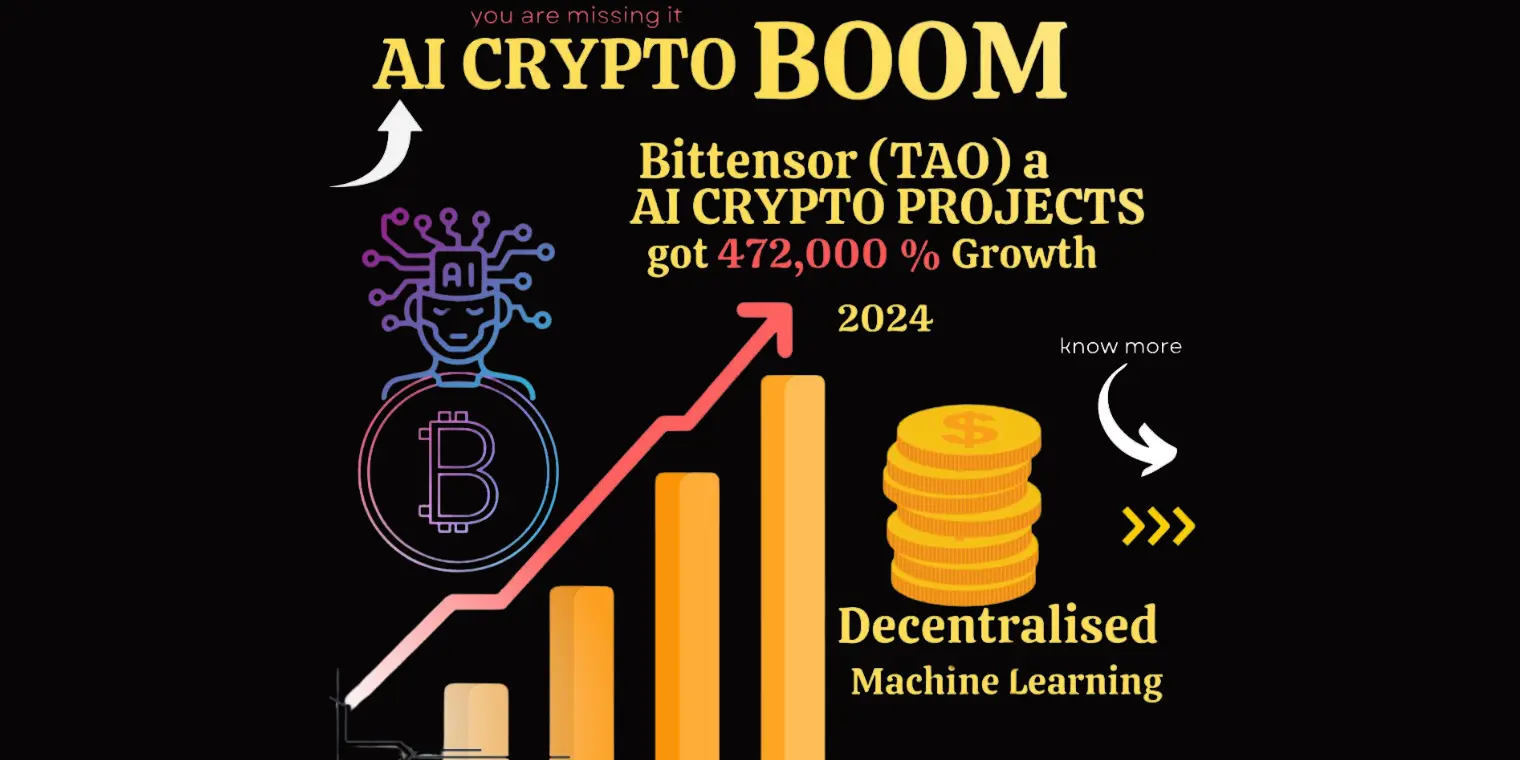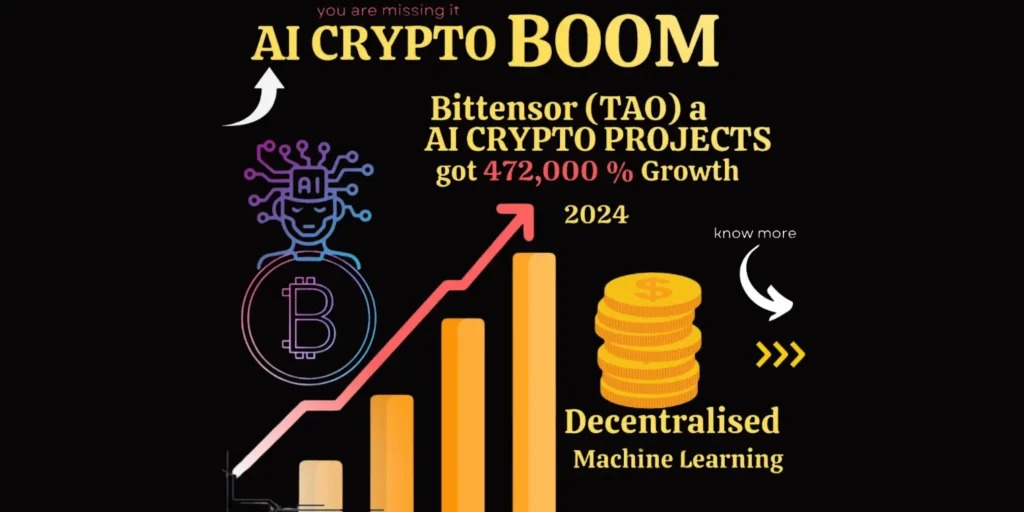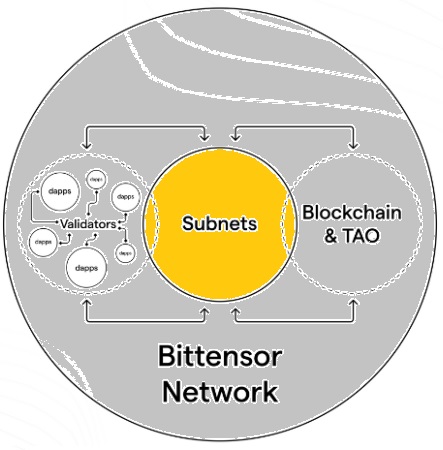
DECENRALISED MACHINE LEARNING (AI)

What is TAO Bittensor ?
Bittensor is transforming machine learning by decentralizing development and creating a peer-to-peer marketplace for AI models. This allows models to collectively pool intelligence into a digital hivemind that rapidly expands and shares knowledge. Much like an unstoppable, exponentially growing library, Bittensor leverages distributed networks and collaboration incentives to drive boundary-pushing innovation in machine learning. The protocol establishes an open, accessible marketplace where machine intelligence becomes a tradable commodity. By engaging a diverse global community, Bittensor fosters decentralized innovation in AI.
Bittensor is a decentralized network similar to Bitcoin that provides censorship-resistant access to machine learning models. It incentivizes participation by directly rewarding contributors for providing computational resources, expertise, and innovation. This establishes a comprehensive, open-source ecosystem for artificial intelligence. The native currency is TAO, which serves as both a reward and access token to the network.
How does the Bittensor work?

Here is an overview of how the Bittensor Protocol works:
Network Architecture
The Bittensor network consists of a set of nodes (miners) that participate in the protocol. Each node runs a Bittensor client software that enables it to interact with other nodes in the network.
Registration
The Bittensor Protocol operates through a registration process that involves the registration of a hotkey. To participate in the Bittensor network and mine Tao tokens, users are required to register a hotkey by either solving a proof of work (POW) or paying a fee using the recycle_register method.
Subtensor
Once registered, a node becomes part of a subnet, which is a specific domain or topic within the Bittensor network. Each subnet has its own set of registered nodes and associated machine learning models.
Validators
Validators play a crucial role in the Bittensor network. They validate the responses and predictions provided by the miners. Validators ensure the integrity and quality of the data and models being exchanged within the network. Validators query miners and evaluate their responses to determine the accuracy and reliability of their predictions.
Validators serve as crucial intermediaries and access points to the Bittensor network, playing a vital role in enabling interaction and providing an interface for users and applications.
Mining
Miners in the Bittensor network provide machine learning services by hosting and serving their locally hosted machine learning models. When a client application requires a prediction, it sends a request to the Bittensor network, which routes the request to a miner that has registered itself as a provider for the required service. The miner processes the request using its locally hosted machine learning model and returns the prediction back to the client via the Bittensor network.
Consensus
The Bittensor network uses consensus algorithms to reach an agreement on the state of the network and ensure the integrity of the data being processed. Consensus mechanisms help prevent double-spending, ensure data consistency, and maintain the overall security of the network.
Incentive
The Bittensor network incentivizes participation and contributions through a token-based economy. Miners and validators are rewarded with tokens for their computational resources, accurate predictions, and other valuable contributions to the network. These incentives encourage active participation and help maintain the network’s stability and efficiency.
One of the most remarkable features of the Bittensor protocol is its incentivization mechanism. It rewards users who contribute valuable data or computational resources with TAO tokens.
Consensus Mechanism of TAO Bittensor
The consensus mechanism rewards valuable nodes in the network by incorporating game-theoretic scoring methods, including the Shapley Value, to assess model performance and reliability. Specifically, the Shapley Value from cooperative game theory assigns each model a score based on its marginal contribution to the overall prediction accuracy and collective intelligence of the Bittensor network. This captures the importance of each model in achieving consensus and making accurate predictions through interacting and exchanging information. The scoring process evaluates models based on their individual predictive capabilities, provision of insights, and alignment with the consensus reached by other models.
Proof of Intelligence
The Bittensor network uses a consensus mechanism called Proof of Intelligence to reward nodes that contribute useful machine learning models and outputs. This mechanism is a variation on Proof of Work and Proof of Stake used in blockchains, but instead of solving math problems, nodes must perform machine learning tasks to prove their intelligence. Nodes with more accurate, valuable model outputs have a higher chance of being selected to add new blocks to the chain and earn TAO token rewards.
Decentralized Mixture of Experts (MoE)
Bittensor employs a decentralized mixture of experts (MoE) model to tackle complex problems that were previously intractable for centralized models alone. Multiple neural networks specialize in distinct aspects of the data and collaborate to generate predictions that surpass any individual expert’s capabilities. By harnessing the collective strengths of specialized models, Bittensor achieves higher accuracy and handles larger data volumes compared to relying on a single model. For example, to generate Python code with Spanish explanations, Bittensor leverages one model adept at programming and another at Spanish. Their collaboration produces comprehensive solutions with accurate code and fluent Spanish, combining their respective strengths. Overall, Bittensor’s decentralized approach allows precise, nuanced responses to multifaceted problems by coordinating the abilities of diverse expert models.
Problem statement which Bittensor want to solve

Two key barriers impede AI’s progress at scale: the immense computing power required for complex models, and the difficulty of building on prior learning rather than starting models from scratch.
Goal of Bittensor
Bittensor aims to create a peer-to-peer marketplace that incentivizes the production of artificial intelligence. Through advanced techniques like mixture of experts and knowledge distillation, the platform establishes a collaborative network where AI producers can sell their models, and consumers can purchase them to enhance their own systems. By fostering a “cognitive economy,” Bittensor facilitates knowledge sharing among researchers, driving the development of more powerful AI. The goal is to advance AI by aggregating individual contributions into a collective intelligence. As computers contribute models and training data to the Bittensor network, they earn rewards in Tao tokens.
Ultimately, the vision is to create a fair, transparent, and accessible marketplace for artificial intelligence. Large companies like IBM, Google and Microsoft, as well as smaller ones, will pay Tao to access the diverse models in the Bittensor network for their own projects. This is because the centralized AI industry is highly inefficient – for example, Google alone spends 75% of its electricity just on machine learning. As AI research compounds exponentially and models must relearn what others have already discovered, these companies will likely find it advantageous to leverage the largest and most effective neural network in the world, provided by Bittensor, to complement their own systems.
Bittensor’s architecture draws inspiration from the cognitive processes of biological neural networks. Each computational unit, called a “Neuron,” has three key components: a model, dataset, and loss function. The Neurons operate collaboratively to optimize their loss functions by leveraging input data and communication between neurons.
The communication between two Bittensor Neurons mirrors synaptic connections in biological networks. Each Neuron has an Axon terminal to receive inputs and a Dendrite terminal to transmit inputs to neighboring Neurons.
During training, a Bittensor Neuron performs two parallel tasks: it sends inputs to neighboring Neurons and processes the same inputs through its internal model. The neighboring Neurons process the inputs with their models and return outputs. The original Neuron consolidates these outputs and updates its gradients by considering both the remote Neurons’ losses and its own local loss. This cooperative learning enables an intelligent, interconnected network of Neurons that parallels biological neural networks.
The total supply of Bittensor (TAO) is 21 million tokens, which is the same as the total supply of Bitcoin. This fixed total supply is designed to limit inflation and maintain the scarcity and value of the token over time.
The distribution of TAO tokens is gradually released over time through mining rewards, staking rewards, and community-driven initiatives. The tokens are used for governance, staking, and as a means of payment for accessing AI services and applications built on the Bittensor TAO network.
Market price of TAO (Bittensor) –
As per Date of publish – 25/03/2024
https://coinmarketcap.com/currencies/bittensor/









